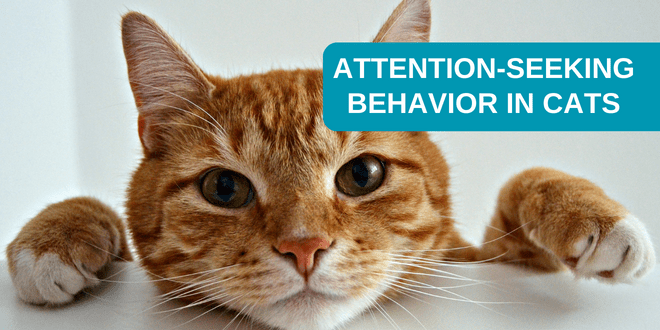
Attention-seeking behavior can occur in any cat at any age but during my consultations I’ve seen it most often in cats who don’t receive adequate stimulation or who are left alone for longer periods.
Signs of Attention-Seeking Behavior in Cats
In general, a cat who is trying to get your attention will resort to whatever works. Typical behaviors include:
- Meowing
- Pawing at you
- Jumping up to be at your level
- Walking around and between your legs (typically in a figure-8 pattern)
- Stealing objects, knocking things off tables
- Biting
- Begging for food
- Following you from room to room
Causes of Attention-Seeking Behavior
This behavior can occur as part of another primary behavior problem or as a result of an underlying medical problem. It can be due to inconsistent schedules, too much time left alone, or improper training. Cats who suffer from separation anxiety or cognitive issues may also often engage in attention-seeking behavior. If the behavior is due to an underlying medical issue, the cat may be seeking your attention as a source of comfort from pain. It can also be because the cat is confused by his discomfort. With attention-seeking behavior, as with any behavior issue, it’s important to get a medical work-up so you can rule out any medical causes to avoid having your cat suffer or be in pain.
Correcting Your Cat’s Attention-Seeking Behavior
Here’s the hard part… most cat parents reinforce the very behavior they don’t like because they acknowledge the cat for displaying attention-seeking behavior. When the cat jumps on the table and starts meowing it’s common for the cat parent to acknowledge the kitty’s presence, whether by scolding, petting, or shooing him away. Even if you reprimand the cat, you’re offering attention. It may not be quite the attention the cat wanted but it’s still attention.
Very often cat parents, in desperation, will offer food to the cat in an attempt to stop the incessant meowing, or other unwanted behavior being displayed. Unfortunately, that just lets the cat know what behavior is successful.
Reprimanding a cat for attention-seeking behavior not only is offering counter-productive attention, but it’s not fair to the cat. If the behavior is due to pain or other medical issue, loneliness, or the fact that the cat is not receiving adequate stimulation, then punishment only creates fear, confusion, and damages the bond between you. It’s not the solution to the problem.
The key to correcting attention-seeking behavior involves these four steps:
- Determine the cause of the behavior
- Ignore the behavior you don’t want
- Provide outlets for the cat’s energy and attention
- Give attention to the cat when quiet or acting appropriately
If the attention-seeking behavior is due to boredom or separation anxiety, your cat needs adequate environmental enrichment. Here are some examples:
- A cat tree by the window for climbing and watching the birds
- Puzzle feeders and puzzle toys for reward-based object play
- Elevated areas for play and resting
- Scratching posts for scratching
- Adequate climbing opportunities
- A consistent schedule for mealtimes
- A consistent schedule of litter box maintenance
- A daily schedule of interactive play therapy
- Consistent affection and interaction from you
- Provide consistency, security, and stimulation
Provide Predictability for Your Cat
If you aren’t consistent in the cat’s feeding schedule, litter box cleaning, playtime, or even when you come home at the end of the day, it can create the need for attention-seeking behavior. If you play with your cat using an interactive toy but you only play every few days, then it’s understandable why he’d engage in trying to get your attention. Cats are hunters who are equipped with incredible senses. They need appropriate energy outlets. They’re also creatures of habit who rely on predictability and consistency in their daily lives. Combine the security of being consistent with the fun of daily reward-based activities and you’ll very likely have a much happier cat who will no longer knock your alarm clock off the nightstand in order to get your attention.
If loneliness is the cause, consider whether the addition of another cat would provide beneficial companionship. If you do decide on this, you’ll need to dedicate the time to do a gradual and positive introduction.
This is the time to take a careful look around your cat’s environment to see what might need some tweaking in the enrichment category. Does your cat have opportunities for fun, discovery, and play throughout the day? If you were a cat would this environment be boring or inviting?
Need More Information?
For more information on cat behavior and training, check out the best-selling books by Pam Johnson-Bennett. Pam’s books are available at bookstores and online. We’ve included Amazon links here on our website.
This article is not intended as a medical diagnosis nor is it a replacement for your cat’s regular veterinary care. This article is for general information purposes only.




